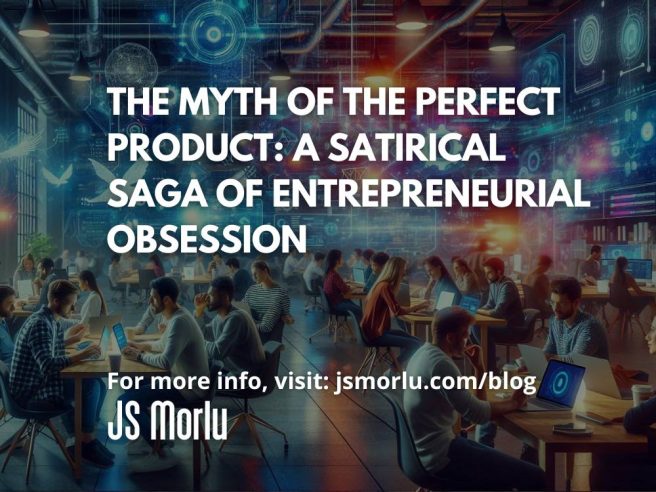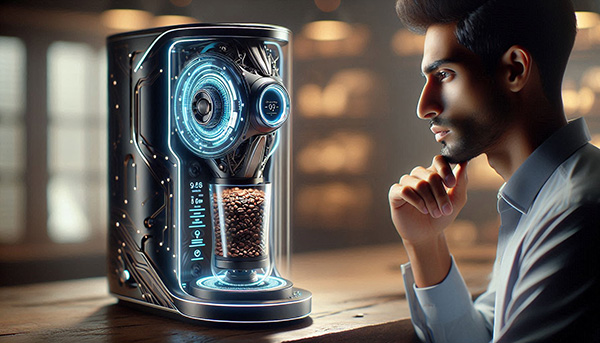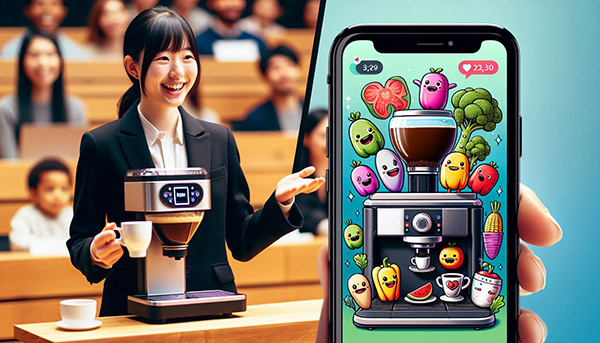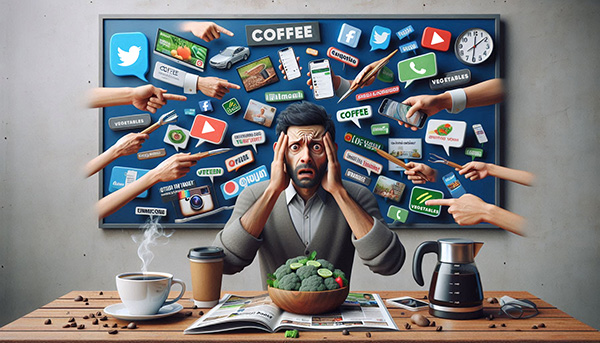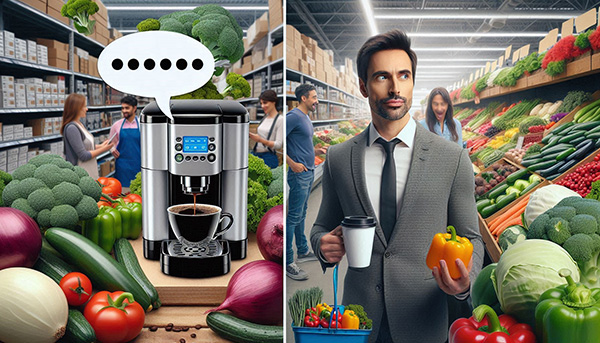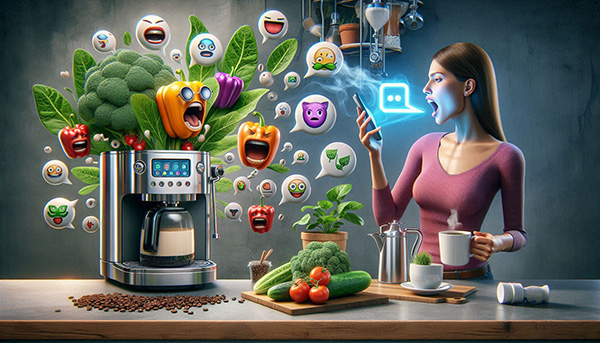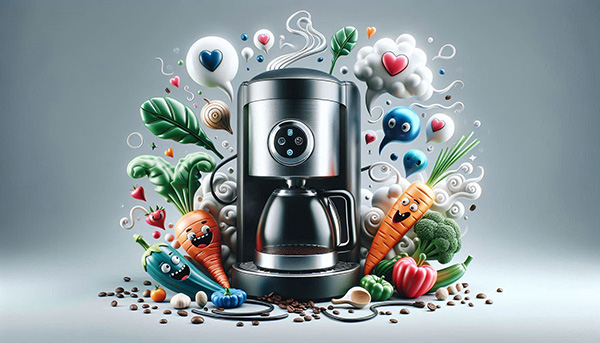By: John S. Morlu II, CPA
In the frenetic, neon-lit corridors of “Innovatia”—a mythical startup haven nestled somewhere between the glitz of Silicon Valley and the caffeinated chaos of a perpetual brainstorm—hundreds of entrepreneurs thrived in their own bubble of delusion. Picture it: a place where dreams are as big as the espresso shots are frequent, and where every founder believes they’ve cracked the code to human progress. In this bustling metropolis of ambition and innovation, every product seemed to bear the weight of a thousand promises, each one more audacious than the last.
Here, in Innovatia, a tech wizard was certain their app would single-handedly eliminate global hunger, while an eco-warrior swore their biodegradable phone case would make plastic pollution a relic of the past. A visionary was convinced that their self-stirring soup pot would revolutionize culinary convenience, while another entrepreneur was absolutely certain that their mood-sensing plant pots could bring about world peace, one fern at a time.
Every entrepreneur in Innovatia clutched their creations as if they were sacred relics, convinced that their product wasn’t just an advancement—it was the next big leap for mankind. They envisioned their innovations not merely as items on a shelf but as the very harbingers of a new era. Surely, their inventions were so groundbreaking, so paradigm-shifting, that even the likes of Elon Musk would be left in awe, drowning in a flood of envy.
Yet, amidst all this self-assured fervor, there lurked an inconvenient truth: the real obstacle wasn’t in the perfection of their ideas or the brilliance of their designs. No, the true challenge lay in the harsh reality of the market. As these hopefuls embarked on their journeys, a stark realization began to dawn upon them. The grandest of innovations, no matter how revolutionary, faced an uphill battle against the indifferent tide of consumer apathy. In the end, the greatest challenge wasn’t creating something extraordinary—it was making the world give a damn.
Chapter 1: The Birth of Product-Love
In the heart of “Innovatia,” a startup mecca where caffeine coursed through the veins of every entrepreneur and brainstorming sessions felt like Olympic sports, lived a particularly enthusiastic visionary named Tom. Tom was the founder of “Brewster,” a company dedicated to creating the most advanced coffee maker the world had ever seen. But Brewster wasn’t just any coffee maker—it was a smart coffee maker, and not just smart in the way your average tech gadget might be. Oh no, Brewster was the coffee maker of the future, designed to brew artisanal blends from beans grown in organic soils blessed by a shaman under a full moon.
Tom had poured his heart, soul, and an ungodly amount of venture capital into Brewster. The beans, lovingly tracked via blockchain, ensured that every sip could be traced back to the precise patch of earth where the beans were coaxed into existence. This wasn’t just about drinking coffee—it was about experiencing the journey of the bean in a way that would make you feel like you were part of some cosmic ritual.
In Tom’s mind, Brewster was nothing short of a caffeinated masterpiece. He had spent five years perfecting this marvel of modern engineering, experimenting with every conceivable configuration. He had consulted with baristas who had also moonlighted as astronauts, because why not add a bit of space-age flair to your morning routine? The prototypes were so complex they required a degree in quantum physics to operate. Tom was convinced that Brewster would single-handedly revolutionize the way humanity experienced coffee. His investors, however, were starting to look a little less like eager supporters and more like people trying to politely escape a very awkward dinner party.
But Tom wasn’t the only starry-eyed dreamer in Innovatia. Across town, in an equally caffeine-soaked corner of this tech-utopia, Sarah was the CEO of “VegTable,” a company that had developed an app designed to help you talk to your vegetables. Yes, you read that right. VegTable was not just another app—it was a revolutionary leap in agritech that allowed you to connect with your carrots, lettuce, and even your more reticent zucchini via AI. The idea was to monitor the “feelings” of your produce and adjust the lighting or water accordingly, thus ensuring that no vegetable ever had to suffer from neglect or poor emotional support.
Sarah believed that VegTable was on the verge of changing the world. She envisioned a future where no cucumber would ever be sad again and where your tomatoes could text you updates about their “growth mindset.” In her mind, VegTable was destined to become a household staple, a digital confidant for every vegetable lover, and a beacon of hope for gardeners everywhere.
Tom and Sarah, with their respective technological marvels, were united by a common thread: they were both hopelessly in love with their products. They believed that their innovations were so groundbreaking, so utterly essential to the advancement of humanity, that the world would surely embrace them with open arms. The idea that their creations might not instantly become global phenomena was a concept so foreign it was practically an alien language.
As Tom sipped his Brewster-brewed coffee, he imagined the accolades that would soon come his way. He pictured himself being interviewed by Oprah, extolling the virtues of his bean-tracking blockchain and the profound impact it had on coffee culture. Sarah, on the other hand, envisioned VegTable’s launch party as a grand celebration where celebrities would line up to chat with their kale and sing praises about how revolutionary it was to have a veggie therapist on call.
Little did they know, their path to greatness would be littered with obstacles more challenging than any algorithm or bean blend. For as much as they were enamored with their products, they were blissfully unaware that the real battle lay not in perfecting their inventions but in convincing a world jaded by endless pitches and half-baked ideas to give a damn.
Their odyssey was only beginning, and the road ahead would be filled with more twists and turns than a coffee stirrer in a triple-shot espresso. The real challenge wasn’t just in making their products—oh no, it was in making the world stop scrolling long enough to notice them.
Chapter 2: Go to Product-Market Fit
In the dazzling realm of Innovatia, where every street corner boasted artisanal smoothie bars and tech startups named after obscure jargon, Tom and Sarah were united by a single, sacred belief: the gospel of product-market fit. To them, this was the holy grail of entrepreneurship. The idea was simple: if you built a product so spectacular, so mind-blowingly amazing, people would rush to it like moths to a flame—or, in Tom’s case, like hipsters to an overpriced, single-origin, blockchain-certified cup of coffee that cost more than a down payment on a house.
Tom and Sarah, along with a legion of other wide-eyed founders, immersed themselves in the startup culture. They attended every conference that promised to unlock the secrets of success—some even promising to reveal how to commune with the spirit of Steve Jobs. They penned a slew of Medium articles, each more self-congratulatory than the last, titled things like “10 Ways My Startup Is Saving the World” and “How My Coffee Maker Can Predict the Future.”
Their lives revolved around an endless cycle of Kombucha-infused brainstorming sessions, networking meet-ups where they discussed disruptive innovation and the latest trends in artisanal beard grooming. Their mantra was simple, and they recited it as if it were a sacred chant: “Build it, and they will come.” After all, they had done the hard part, hadn’t they? They had crafted products that would make even the most jaded tech mogul shed a tear of joy.
Or so they thought.
It turns out that while Tom and Sarah were busy perfecting their products, the world had quietly slipped into a new phase of entrepreneurial reality. The market, it seemed, was no longer just interested in how groundbreaking your product was. It had moved on to a far more perplexing challenge: how to actually sell it. Welcome to the brave new world of Go-to-Market Fit—a place where having a revolutionary product was just the beginning of a much longer and more convoluted journey.
Tom, ever the optimist, took his Brewster to a local startup conference, where he was surrounded by other self-assured visionaries. He proudly demonstrated Brewster’s blockchain-enabled bean tracking and its ability to brew coffee at a temperature so precise it could only be described as “thermodynamically perfect.” The audience, however, seemed less enchanted and more perplexed. One attendee even asked if the blockchain feature was necessary or if it was just a really elaborate way to get people to think Brewster was worth $800.
Undeterred, Tom spent countless hours tweaking his online store, convinced that a snazzier website would finally attract the crowds he dreamed of. He made the mistake of investing heavily in SEO—Search Engine Optimization—thinking that if someone Googled “coffee maker,” his would miraculously pop up. Tom soon discovered that being the top result for “coffee maker” was about as useful as being the first one to reach the top of a very empty mountain. The site traffic was impressive, but the sales remained as flat as a poorly brewed espresso.
Sarah, meanwhile, had her own epiphany. She spent weeks pushing VegTable as the next big thing in app technology. She plastered every possible social media platform with ads featuring heartwarming videos of vegetables expressing their gratitude for proper care. Yet, she was greeted with confusion more than enthusiasm. “Does the app let me talk to my food before I eat it, or is it just another gimmick?” was a common question. Sarah’s approach had clearly missed the mark. VegTable’s “vegetable therapy” did little to quell the public’s skepticism or pique their interest.
Realizing they were missing something crucial, Tom and Sarah sought the wisdom of a marketing guru, a self-proclaimed “channel fit” expert named Glenn. Glenn was notorious for his extravagant seminars and outlandish claims, such as predicting the next big trend in snacks and fashion with almost mystical accuracy. He hosted seminars that combined motivational speeches with intense sales tactics, often involving a fire-breathing dragon—metaphorically speaking, of course.
Glenn’s advice was blunt: “You’ve got a great product, but who cares? The market doesn’t want a perfect product; it wants a perfect pitch. You need to find the right way to present your innovation so it actually resonates with people.”
Tom and Sarah were baffled. Glenn explained that it wasn’t enough to have a revolutionary product; they needed to find the right channels to reach their target audience. The world wasn’t just looking for something new—it was looking for something that spoke to its needs and desires. And speaking of needs, it turned out that neither coffee aficionados nor vegetable enthusiasts were as ready for their innovations as Tom and Sarah had hoped.
Armed with this new understanding, Tom and Sarah embarked on a journey of reinvention. Tom decided to partner with local office supply chains and co-working spaces, where his coffee maker could be placed in front of a captive audience of over-caffeinated, under-slept tech workers. The strategy was less glamorous than he had envisioned, but it put Brewster right where it needed to be—in the hands of people who needed it.
Sarah took a different approach. She teamed up with community gardens and organic food markets, turning VegTable into a novelty that offered a fun and quirky twist on everyday gardening. She created interactive booths where visitors could “talk” to their plants through the app, engaging with the concept in a tangible way. It wasn’t the high-tech dream she’d originally envisioned, but it got people talking, laughing, and actually using her app.
In the end, Tom and Sarah learned a valuable lesson: having a product that’s ahead of its time is only half the battle. The real challenge is figuring out how to connect that product with people who not only want it but also understand it. It wasn’t about the perfect coffee maker or the ideal vegetable app. It was about finding the right audience and the right way to reach them.
So, as Tom and Sarah adjusted their strategies and began to see some results, they realized that in the wild world of startups, success was less about having the next big thing and more about having the next big idea on how to sell it. And while they might not have been the next Steve Jobs, they were at least one step closer to making their dreams a reality—one cup of coffee and one happy carrot at a time.
Chapter 3: The New Reality: Channel Fit
Welcome to the wild world of Channel Fit, where finding the right distribution strategy is as tricky as dating but with less romantic candlelight and more algorithmic heartbreak. Instead of finding your soulmate, you’re on a quest to discover the perfect distribution channel for your product. It’s a realm where the wrong choice can leave you swiping left on sales and where the right move can transform your product from a lonely outcast to the prom king of the marketplace.
Think of Channel Fit as the dating game of the business world. Imagine you’re Tom, and Brewster is your charming but slightly nerdy coffee maker. You’re convinced that all you need to do is get Brewster in front of the right coffee aficionados, and it’ll be love at first sip. With stars in his eyes and a heart full of optimism, Tom launched his online store with a landing page that looked like it had been stolen straight out of the early 2000s. Picture neon gradients, Comic Sans fonts, and a layout that even a dial-up connection would find offensive.
Tom’s grand plan was to conquer the world of coffee lovers using SEO. He had faith that if someone Googled “best coffee maker,” Brewster would be their top hit. He envisioned a line of customers wrapped around the block, waiting for their chance to experience the magic of blockchain-verified coffee. But instead of the bustling success he’d imagined, Tom’s SEO strategy delivered only crickets. To make matters worse, he spent $10,000 on Facebook ads, naively believing that a sprinkle of social media sparkle would do the trick. The outcome? Two sales—one of which was from his ever-supportive mother, who probably only bought the coffee maker to avoid another “Isn’t this amazing?” dinner conversation.
Meanwhile, Sarah’s VegTable was having its own channel fit misadventure. Sarah, convinced that her app needed to appeal to the eco-conscious millennial crowd, plastered Instagram with ads featuring a forlorn kale plant, dramatically lit with a single spotlight that looked like it was auditioning for a role in a soap opera. She imagined millennials scrolling through their feeds, their hearts melting at the sight of a sad, neglected vegetable, and being compelled to download the app to prevent further vegetable anguish.
Instead of drawing in the eco-friendly, socially aware crowd she had envisioned, Sarah’s campaign attracted a curious group of conspiracy theorists. These folks were convinced that VegTable was part of a grand scheme of “vegetable surveillance” designed to monitor their every culinary move. Sarah found herself at the center of a bizarre storm of “Big Vegetable” accusations and had to navigate a minefield of bizarre theories involving microchips in carrots and secret government-funded broccoli experiments.
As Tom and Sarah fumbled through their distribution channel fiascos, they began to realize that channel fit was less about what they were selling and more about how and where they were selling it. The art of channel fit required more than just a great product—it demanded a strategic understanding of the audience and a touch of marketing finesse. It was about finding the right stage for your performance, where the audience wasn’t just a random crowd but a group that actually cared about the show.
Tom decided it was time to rethink his approach. He realized that an outdated website and a scattergun Facebook ad strategy were not enough. He pivoted to targeting specialty coffee shops and local cafes where the coffee culture thrived. He started offering demonstrations and tastings, where he could show off Brewster’s blockchain wizardry in person. It wasn’t glamorous, but it worked. Brewster slowly began to find its tribe among coffee aficionados who appreciated the ritual and the technology behind each brew.
Sarah, on the other hand, faced her own epiphany. She decided to shift her focus from broad social media campaigns to more targeted partnerships with community gardens, organic food markets, and even culinary schools. By engaging with people who genuinely cared about plant health and sustainable gardening, VegTable began to attract users who were interested in the quirky, innovative app she had created. Sarah’s approach may not have gone viral, but it resonated with those who found genuine value in VegTable’s unique offering.
In the end, Tom and Sarah discovered that the path to success in Channel Fit wasn’t paved with grandiose visions or flashy ads. It was about understanding their audience, meeting them where they were, and engaging with them in a meaningful way. They learned that finding the right distribution channel was like finding the perfect dance partner: it required a bit of finesse, a lot of trial and error, and the occasional awkward shuffle to get it right.
So, as Tom and Sarah continued their respective journeys, they learned that channel fit was an evolving art form—one that demanded flexibility, creativity, and a willingness to adapt. And while they might not have danced their way to fame, they found their rhythm in the ever-changing dance of the market, one customer, and one happy kale plant at a time.
Chapter 4: It’s All About the How
As Tom and Sarah stumbled through the fog of startup uncertainty, they began to grasp a hard truth: no matter how much they adored their products, if nobody knew about them, their innovations were about as relevant as a dial-up modem in an age of fiber optics. It was time to move from mere existence to the spotlight—and not just any spotlight, but the right one.
Tom had his own epiphany. He took Brewster to a startup accelerator, a place filled with caffeinated dreamers and weary mentors. His mentors, who had likely seen every flavor of startup delusion imaginable, dropped the truth bomb with the gentleness of a sledgehammer. “Tom,” one of them said, “no one cares about your coffee maker. What they care about is whether they can get their caffeine fix before their 9 a.m. Zoom call, and how quickly they can do it without missing the first meeting of their day.”
Tom’s world came crashing down in an instant. His pride and joy—the Brewster coffee maker, which he had envisioned as a beacon of coffee-making perfection—was being reduced to a mere participant in the daily race against the clock. The revelation was swift and brutal. Tom didn’t need to create the world’s most amazing coffee maker; he needed to create the world’s easiest coffee maker to buy.
So, Tom pivoted with the grace of a trapeze artist in mid-air. He struck a deal with a national office supply chain to stock Brewster in every business park across the country. It wasn’t glamorous, but it was effective. The new strategy wasn’t about dazzling coffee connoisseurs with blockchain transparency or artisanal beans; it was about making sure Brewster was within arm’s reach of every harried office worker in need of a quick caffeine fix. People didn’t buy Brewster because it was the best—they bought it because it was conveniently there when they needed it.
Sarah’s path to channel enlightenment was a bit more of a rollercoaster. After her Instagram ad campaign had flopped into a conspiracy theorist’s dream, she pivoted to the realm of YouTube influencers—vegetable enthusiasts, to be exact. These influencers created heartwarming, tear-jerking videos about how their houseplants had started communicating better thanks to VegTable. There were touching moments where cucumbers shared their feelings and radishes confessed their fears.
The results were…mixed. Viewers were entertained by the eccentric videos, and many left with a smile, but the app downloads? Not so much. It turned out that while people enjoyed the novelty of “talking” vegetables, they weren’t quite ready to engage in deep conversations with their zucchinis.
Desperation, however, is a powerful motivator. In a final, somewhat unorthodox move, Sarah partnered with a local farmers’ market. VegTable was embedded into every stall, and visitors could actually “talk” to the vegetables before buying them. Want to know if that zucchini was fresh? Ask it yourself! It was a little creepy, with vegetables seemingly staring back at you from the stalls, but the novelty of the experience turned VegTable into a quirky hit among foodies and curious market-goers.
People flocked to the farmers’ market not just to buy fresh produce, but to experience the weird, wonderful world of VegTable. Sure, it wasn’t exactly the viral success Sarah had initially envisioned, but it had turned into something much more charmingly eccentric and endearing. VegTable became a local legend, a beloved oddity that provided a whimsical, if slightly unsettling, way to connect with your produce.
Tom and Sarah’s journeys illustrated a crucial lesson in the world of startups: it’s not enough to have a great product; you have to master the art of channel fit—finding the how to get your product into the hands of the right people. Whether it’s integrating your product into office supply chains or having your app chat with vegetables, success in the startup world often hinges on the ability to adapt and think outside the box.
While Tom and Sarah’s approaches might not have been the stuff of legend, they each found their own ways to make their products shine in the chaotic world of modern entrepreneurship. Tom’s Brewster became a ubiquitous presence in office break rooms, while Sarah’s VegTable carved out a niche as the quirky, conversational app that made farmers’ markets just a bit more magical. Both discovered that sometimes, the road to success is paved with unexpected detours, a dash of creativity, and the occasional chat with a disgruntled zucchini.
Chapter 5: Enter the Copycats
In the chaotic world of entrepreneurship, achieving any measure of success is akin to painting a giant bullseye on your back. Just as Tom and Sarah were reveling in their newfound distribution strategies and basking in the warm glow of their modest successes, the copycats arrived—eager to ride the coattails of innovation and, more importantly, to cash in on the buzz without the hassle of original thought.
Enter Dan, the ambitious founder of “CoffeeBot.” CoffeeBot wasn’t about brewing superior coffee or charming baristas with blockchain technology; it was a coffee maker with a twist—literally. This device didn’t make better coffee; it simply yelled at you until you drank the coffee you already had. Imagine a coffee machine that, instead of brewing, stood on your kitchen counter shouting motivational quotes and threats. “Drink that coffee now, or I’ll tell everyone you skipped your morning brew!”
Dan wasn’t delusional about CoffeeBot’s brilliance—he knew it was utter nonsense. But he also understood one crucial thing: the world is full of people who might need a little nudge (or a virtual kick in the pants) to get through their day. He quickly partnered with a major tech firm to distribute CoffeeBot to offices around the globe. The result? Within six months, CoffeeBot had outsold Brewster. Employees were hooked on the idea of an overzealous gadget that reminded them to drink their coffee. It turned out that sometimes, the best way to gain traction was by embracing the sheer absurdity of the product and making sure it was impossible to ignore.
Meanwhile, Sarah’s nemesis in the app world was a dastardly creation called “PlantTalk.” PlantTalk didn’t innovate so much as it expanded. While VegTable could talk to vegetables, PlantTalk took it up a notch by adding communication with houseplants, succulents, and even that questionable fern you inherited from your aunt. Marketed as “the voice of your greenery,” PlantTalk promised to give your plants a megaphone to express their leafy grievances.
Sarah watched in horror as PlantTalk skyrocketed to fame, its success primarily due to superior customer service. It turned out that merely talking to your lettuce wasn’t enough—you needed a responsive helpline too. PlantTalk’s customer support was legendary. Users could call in, chat online, or even send a snail mail letter to get their questions answered by a team of highly trained “Plant Whisperers.” “Is my cactus dehydrated?” “Why is my fern looking droopy?” PlantTalk had answers, and they came with a side of empathetic, plant-friendly advice.
Sarah’s VegTable, while charming in its own right, lacked this level of customer service finesse. The app’s support team was overwhelmed by the influx of confused users who had questions ranging from “How do I know if my zucchini is happy?” to “Can my kale develop a complex emotional life?” The lack of timely, personalized responses led to a user exodus towards PlantTalk, where every leaf could be heard and every stem cared for.
As Tom and Sarah faced the onslaught of copycats, they had to grapple with a sobering reality: success often invites imitation. The trick was to recognize that while imitation was inevitable, there was still room to carve out a niche. For Tom, this meant embracing the absurdity of CoffeeBot as a reminder that in the world of tech, sometimes the weirdest ideas could become the most memorable. For Sarah, it was about understanding that customer service could be a game-changer—even for an app designed to chat with your Brussels sprouts.
Tom decided to rethink Brewster’s approach. He introduced new features, like a “coffee guilt trip” mode that gently shamed you into brewing a fresh pot if you hadn’t used your current coffee. He also began collaborating with office wellness programs to integrate Brewster into corporate health initiatives, combining caffeine with a dose of productivity.
Sarah, on the other hand, took a different route. She revamped VegTable’s customer service, introducing a 24/7 chat feature with real-life horticulturists who could offer real-time advice. She even added a “Plant of the Month” feature where users could learn about different plants and how to keep them emotionally fulfilled.
In the end, Tom and Sarah learned that while copycats could be a nuisance, they also served as a reminder that their initial success wasn’t a fluke. It was a sign that they had created something of value—something worth imitating. By adapting to the competition and refining their approaches, they could reclaim their spots in the spotlight.
So, as the copycats continued to churn out their own versions of caffeine accountability and leafy conversations, Tom and Sarah pushed forward, using their experiences to innovate and improve. After all, in the ever-evolving world of startups, the key to long-term success wasn’t just about dodging the copycats—it was about staying ahead of the curve and continuing to delight customers, even when they were being bombarded by the next big thing.
Chapter 6: The Inevitable Merger
By this point in their entrepreneurial odyssey, Tom and Sarah had undergone the kind of growth that only comes from the painful realization that building a product is only half the battle. The real challenge? Getting it in front of people who care, or at the very least, people who aren’t busy discussing their avocado toast on social media.
In a twist of fate that would make a Shakespearean playwright envious, Brewster and VegTable decided to merge, giving birth to a new monstrosity—or should we say, masterpiece—called “BrewTable.” BrewTable was the lovechild of coffee and vegetables, a device that could not only brew your artisanal, blockchain-certified coffee but also engage in heartfelt conversations with your heirloom tomatoes while doing so.
Imagine a coffee maker with a personality so engaging it could strike up a dialogue with your zucchini about its dreams of becoming a star in a salad. That’s BrewTable for you. It was part coffee maker, part vegetable whisperer, and all the rage among a very niche, very peculiar demographic: urban farmers with a penchant for artisanal coffee and a deep emotional connection to their heirloom vegetables.
The press release for BrewTable was nothing short of poetic. “Introducing BrewTable: Where Your Coffee and Your Kale Converse in Harmony.” It featured a picture of a sleek coffee machine with a kaleidoscope of colorful vegetables surrounding it, each with a little speech bubble saying things like, “I’m feeling fresh today!” and “Is this light level optimal for my chlorophyll production?”
Tom and Sarah, armed with their new creation, ventured into the world of product marketing with a fervor that could only be described as “zealot-like.” They hosted launch parties where guests could sip on their perfectly brewed coffee while chatting with their potted plants. The highlight of these events was a live demonstration where BrewTable brewed coffee while engaging in a spirited debate with a tomato about the merits of sunlight versus shade.
The marketing for BrewTable was a masterclass in niche targeting. They found their sweet spot in urban farmers who, let’s face it, had too much time on their hands and a complex relationship with their produce. These were the individuals who not only enjoyed growing their own food but who also reveled in discussing the emotional well-being of their vegetables. BrewTable quickly became a symbol of their sophisticated lifestyle—a bridge between the artisanal coffee craze and the farm-to-table movement.
The success of BrewTable wasn’t about groundbreaking innovation or revolutionary technology; it was about finding the right market fit. It turned out that urban farmers were the perfect audience. These were the folks who had already embraced the intersection of technology and agriculture, who saw their vegetables not just as food but as cherished companions. They loved BrewTable not because it brewed coffee or talked to their vegetables, but because it validated their belief that their lifestyle was both unique and superior.
To capitalize on this newfound success, Tom and Sarah went all-in on marketing campaigns that featured heartwarming testimonials from satisfied customers. “I used to feel so disconnected from my tomatoes,” one urban farmer claimed, “but now, with BrewTable, we have daily conversations. They even tell me when they’re feeling under the weather!” Another boasted, “My coffee never tasted better now that I know my beans and beets are on speaking terms.”
As the popularity of BrewTable surged, Tom and Sarah were invited to speak at conferences about the future of integrated products and the importance of emotional connections in consumer goods. Their story became a case study in how two seemingly unrelated products could merge to create something truly unique. The lesson? Sometimes, success doesn’t come from inventing something entirely new but from combining what already exists in innovative ways.
BrewTable also became a social media sensation. Users shared photos of their BrewTable setups, featuring coffee mugs adorned with witty vegetable puns and Instagram stories of their cucumbers and coffee machines having existential conversations. The product was a hit not just because it was functional, but because it tapped into a cultural zeitgeist—a growing movement that celebrated the quirky and the absurd.
In the end, the BrewTable phenomenon was a testament to the idea that finding the right market fit is as crucial as the product itself. Tom and Sarah had taken their individual failures and combined them into a success story that was as bizarre as it was brilliant. BrewTable wasn’t just a product; it was a cultural icon, a testament to the power of innovation through combination, and a reminder that sometimes, the strangest ideas can become the most beloved.
So, as Tom and Sarah basked in the glow of their success, they knew that the journey was far from over. The world of startups was still full of challenges, opportunities, and, of course, copycats. But for now, they were content to watch their BrewTable thrive, knowing that in the ever-evolving landscape of entrepreneurship, sometimes the most unexpected combinations can lead to the most delightful outcomes.
Chapter 7: The Moral of the Story
Dear reader, if there’s one lesson to glean from the glorious, coffee-scented chaos of Tom, Sarah, and the delightful disaster known as BrewTable, it’s this: No one cares about your product as much as you do. You may have crafted the pinnacle of human ingenuity, a marvel of modern engineering, or the world’s most socially aware vegetable app, but unless you can figure out how to sell it, your genius will languish in the obscurity of forgotten inventions.
Let’s face it—every entrepreneur thinks their product is the next sliced bread, the panacea for all human problems, the holy grail of innovation. Tom thought Brewster was a coffee-maker so extraordinary that it would inspire sonnets and make baristas weep. Sarah envisioned VegTable as the app that would revolutionize our emotional connection with vegetables, making carrots and cucumbers the next big thing in digital dialogue. But when push came to shove, they learned a hard truth: a product is only as good as its market fit.
It’s not just about achieving that elusive “product-market fit”—the nirvana of entrepreneurial theory where your product meets the market’s needs perfectly. Oh no, dear reader, the real game-changer is go-to-market fit. It’s the fine art of getting your marvel of innovation into the hands of people who will actually care. Think of it like dating: finding the right distribution channel is like finding that one special person who won’t swipe left when they see your app. The world has moved beyond just creating cool things; it’s about making sure those things don’t sit gathering digital dust in some forgotten corner of the internet.
Tom and Sarah’s tale is a glorious comedy of errors, a parade of misplaced passions and misguided attempts. They spent years perfecting their products, obsessing over every detail like a master chef who’s lost sight of the fact that the customers just want a good meal. They poured their hearts and souls into their inventions, only to find that their love wasn’t quite enough to get them through the checkout process.
Tom’s misadventures in online marketing were the stuff of legend. He invested thousands of dollars into Facebook ads, convinced that the perfect ad campaign would magically attract customers like bees to honey. Instead, he found himself celebrating every sale like a lottery winner, with his mom being his most loyal customer. It was a harsh awakening to realize that even the most caffeinated of dreams need more than just a good ad.
Sarah’s attempt to charm millennials through Instagram was equally poetic in its failure. Her ads, featuring a sorrowful kale plant, were supposed to tug at the heartstrings of a generation obsessed with organic, ethically-sourced everything. Instead, she ended up attracting conspiracy theorists convinced that VegTable was part of a sinister vegetable surveillance plot. The moral? Sometimes, a crying kale plant is just a crying kale plant, and not everyone wants to engage in deep conversations with their produce.
But the real zinger of the story is that, despite their numerous failures and missteps, Tom and Sarah eventually found success through sheer, unadulterated perseverance. BrewTable didn’t become a sensation because it was the best product on the market. It became a hit because Tom and Sarah finally understood the true essence of market fit. They embraced their niche audience with open arms, realizing that selling out just a little bit—and finding the right way to do it—was the key to their success.
So, as you embark on your next grand adventure in the world of entrepreneurship, remember this vital nugget of wisdom: It’s not the love you have for your product that counts; it’s how much effort you put into selling it. Whether it’s charming your way into the hearts of Instagram influencers, finding the perfect distribution channel, or making your product fit into a market you hadn’t initially considered, the real secret is persistence, adaptability, and a touch of humility.
As Dan from CoffeeBot so eloquently put it (and he was a man who knew a thing or two about selling things people didn’t know they needed), “Get up, drink the coffee, and sell the darn thing already.” Because in the grand theater of entrepreneurship, your product might be a dazzling star, but without a savvy marketing strategy, it’ll never get its standing ovation.
And so, dear reader, as you gaze into the horizon of your next brilliant idea, remember to balance your passion with a hefty dose of pragmatism. Your product might be revolutionary, but the real magic happens when you make sure the world knows it, loves it, and, most importantly, buys it.
Author: John S. Morlu II, CPA is the CEO and Chief Strategist of JS Morlu, leads a globally recognized public accounting and management consultancy firm. Under his visionary leadership, JS Morlu has become a pioneer in developing cutting-edge technologies across B2B, B2C, P2P, and B2G verticals. The firm’s groundbreaking innovations include AI-powered reconciliation software (ReckSoft.com) and advanced cloud accounting solutions (FinovatePro.com), setting new industry standards for efficiency, accuracy, and technological excellence.
JS Morlu LLC is a top-tier accounting firm based in Woodbridge, Virginia, with a team of highly experienced and qualified CPAs and business advisors. We are dedicated to providing comprehensive accounting, tax, and business advisory services to clients throughout the Washington, D.C. Metro Area and the surrounding regions. With over a decade of experience, we have cultivated a deep understanding of our clients’ needs and aspirations. We recognize that our clients seek more than just value-added accounting services; they seek a trusted partner who can guide them towards achieving their business goals and personal financial well-being.
Talk to us || What our clients says about us

